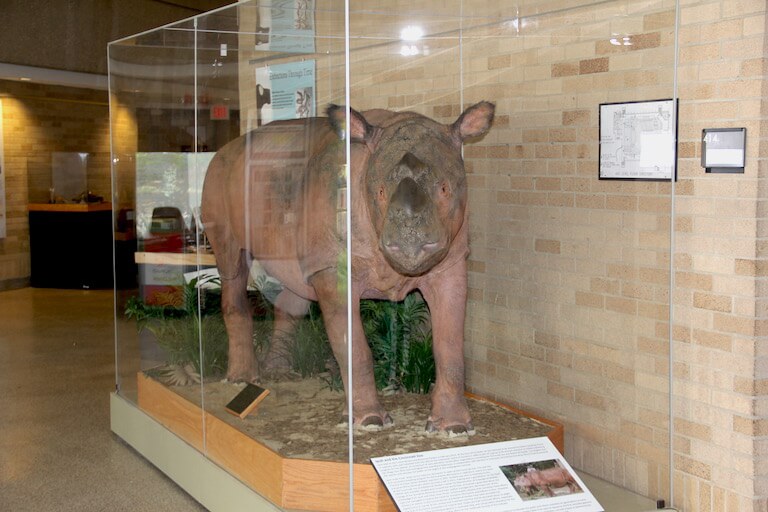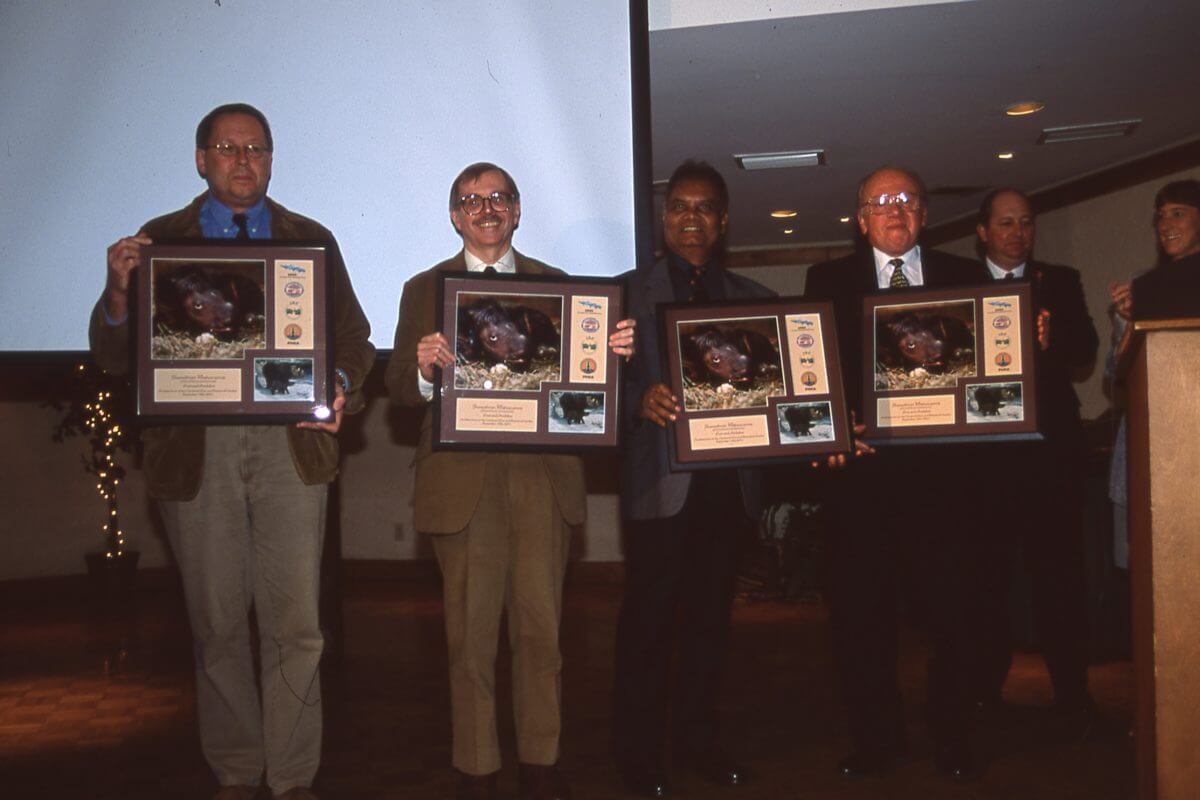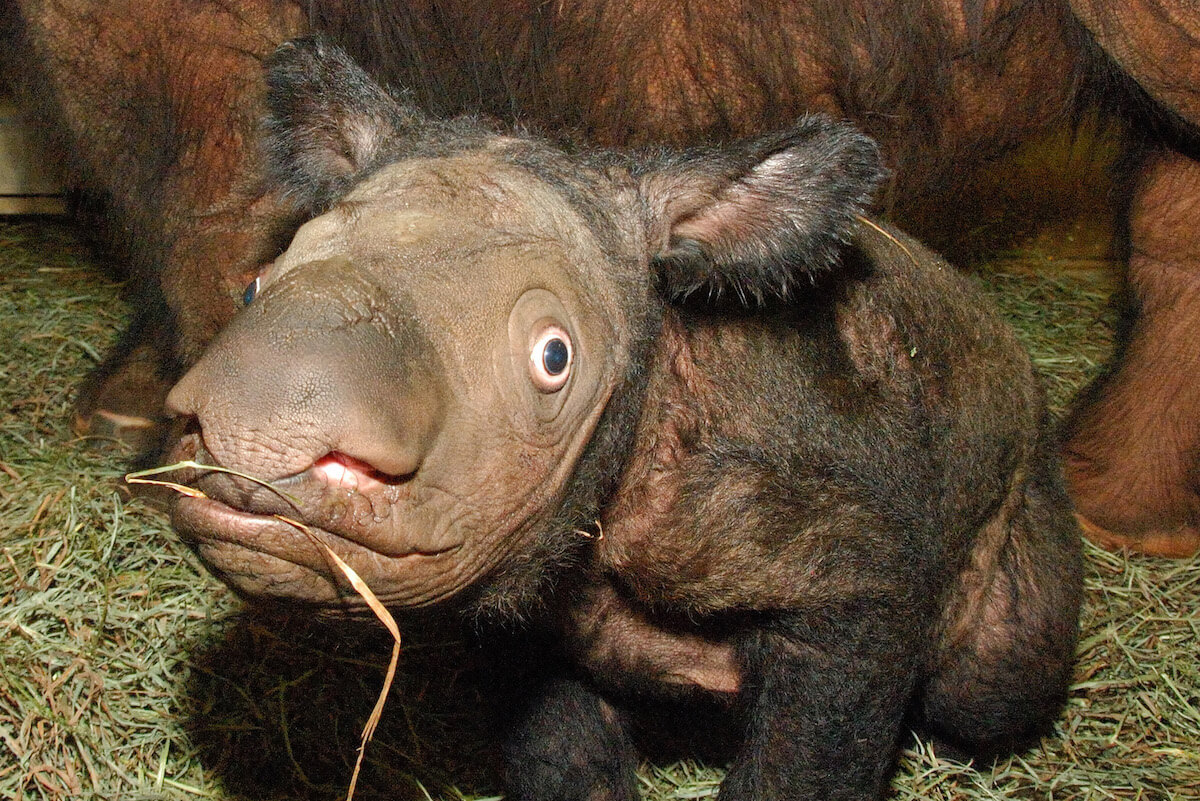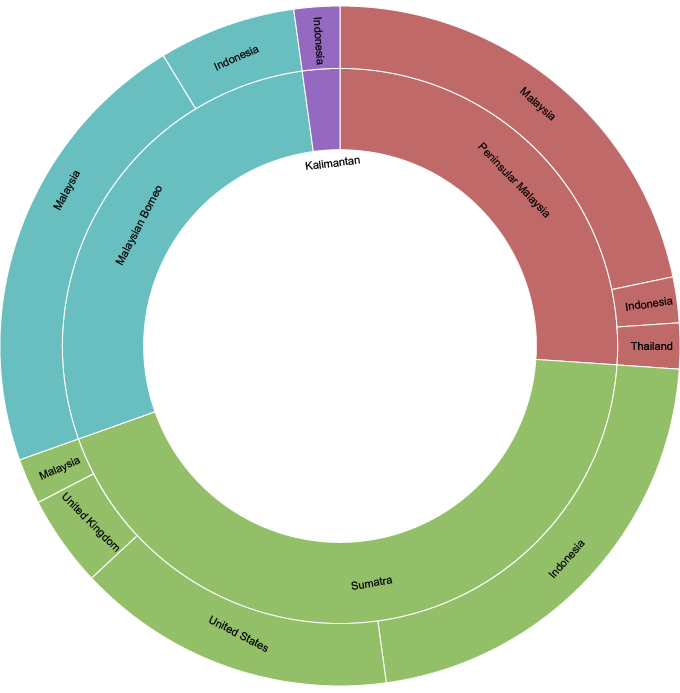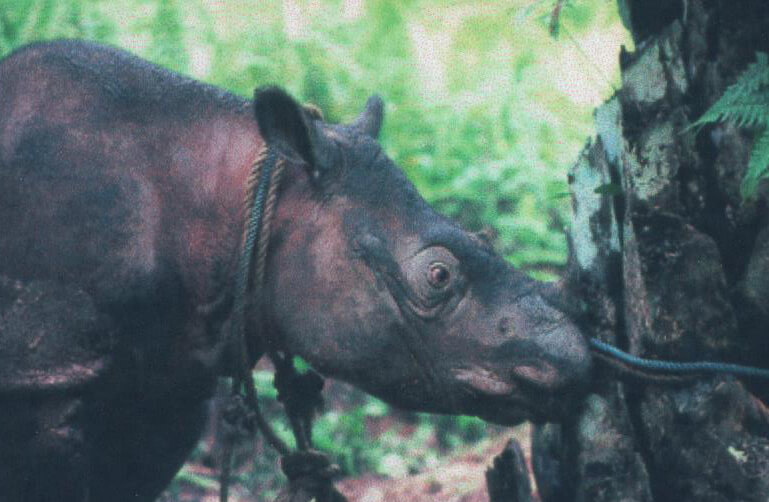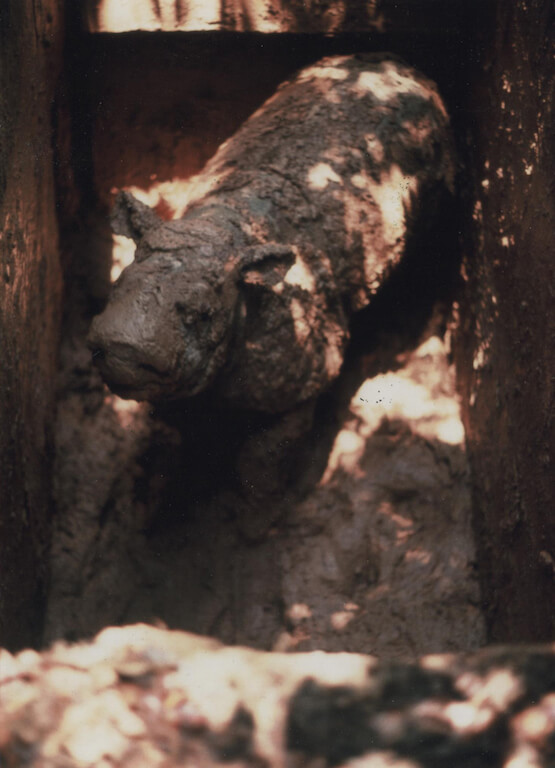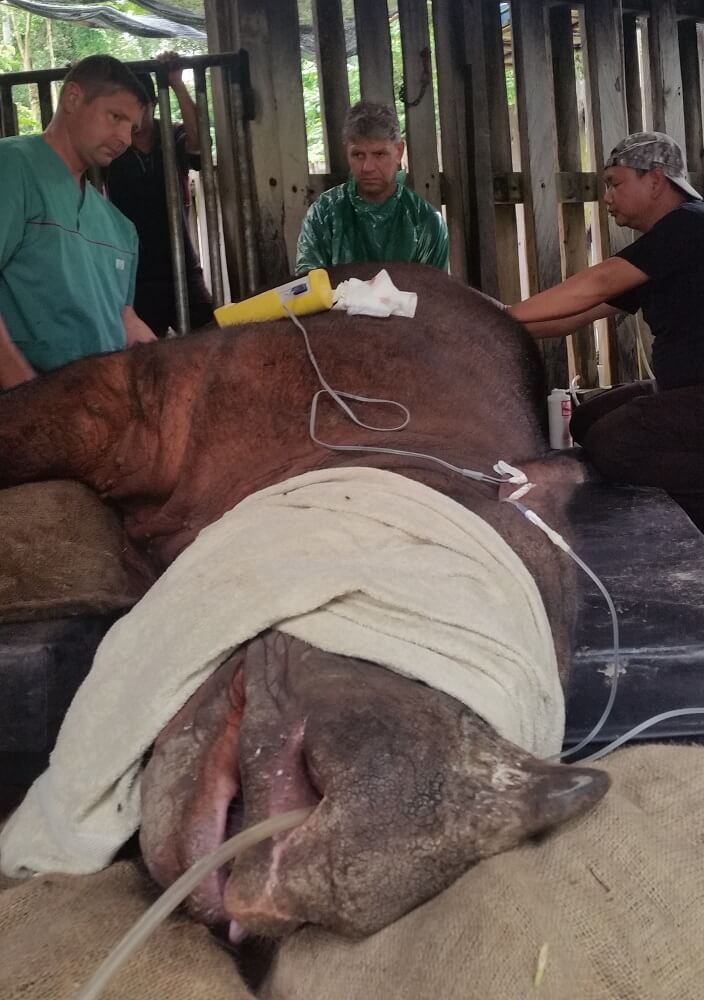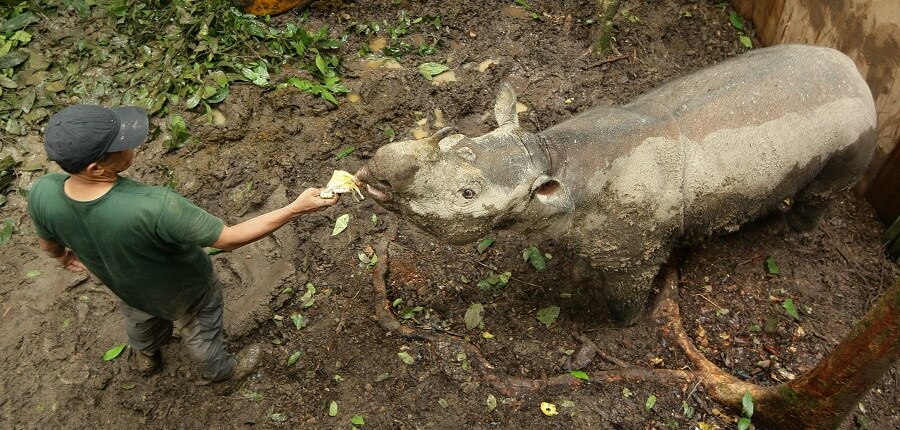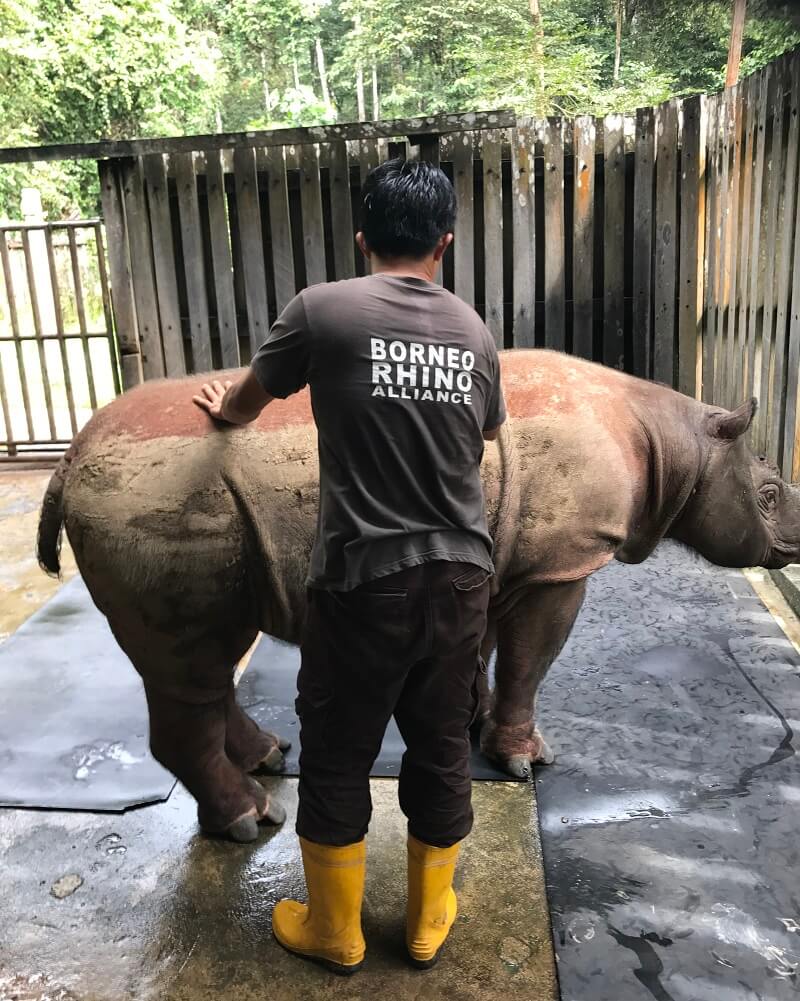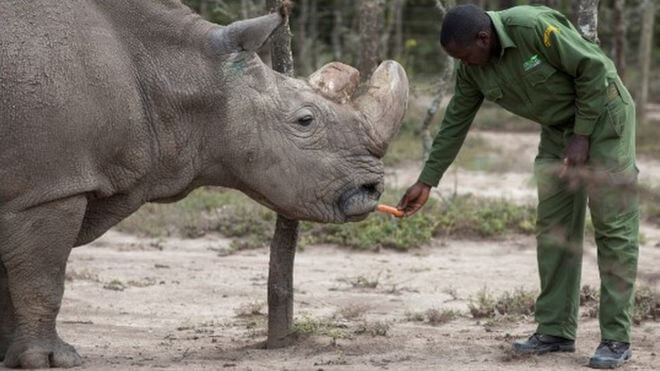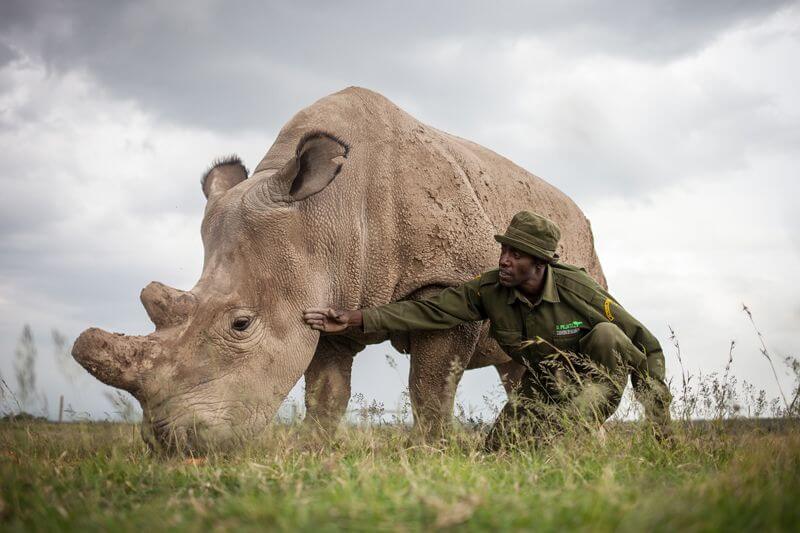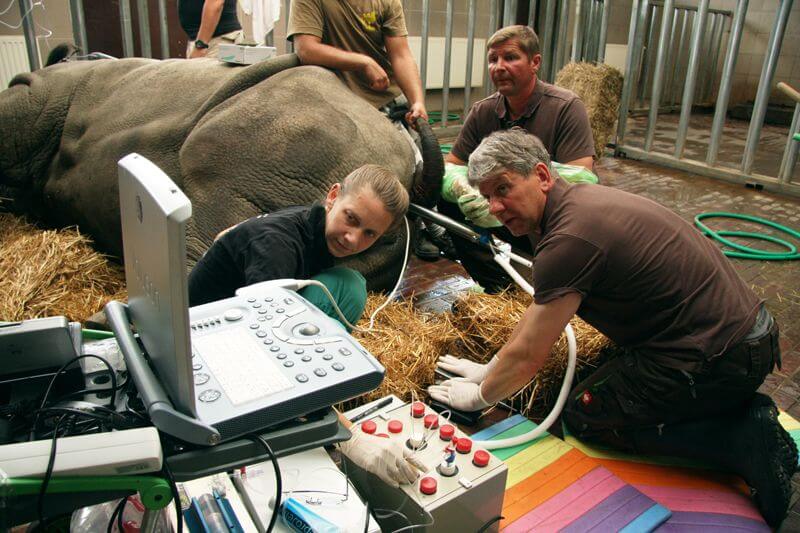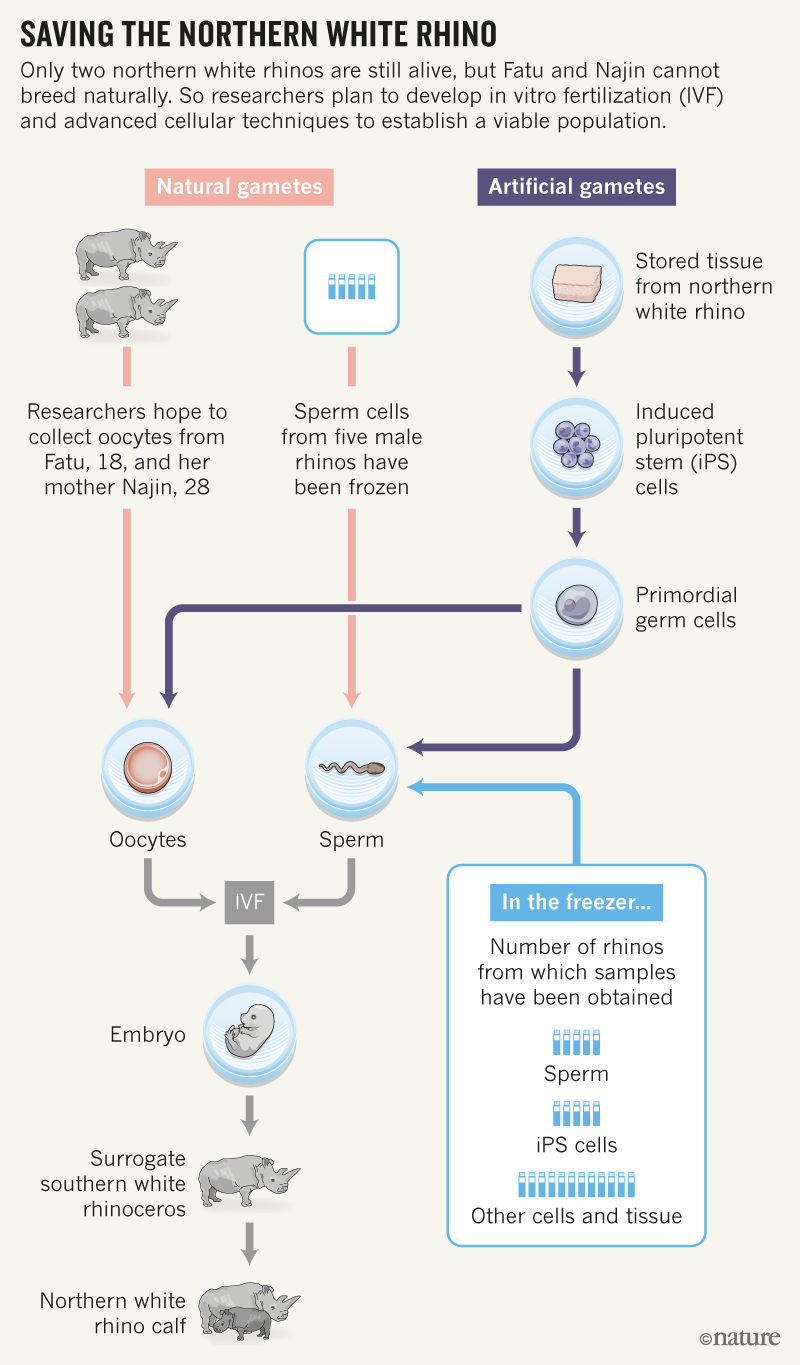Capturing Sumatran rhinos was one thing. Keeping them alive turned out to be another thing entirely.
An article by Jeremy Hance published in Mongabay by 24 SEPTEMBER 2018
- An agreement to launch a captive breeding program was brokered in 1984. By 1985, key participants began pulling out, including the Malaysian state of Sabah.
- Despite the setbacks, efforts to capture rhinos quickly got up and running. Keeping the animals healthy proved to be a much greater challenge.
- By 1995, nearly half of the 40 rhinos caught were dead, and none of them had successfully bred in captivity.
This is the second article in the Mongabay four-part series “The Rhino Debacle.” Read Part One here.
No one knows when humans first encountered the Sumatran rhinoceros, the smallest, hairiest, most loquacious and arguably strangest of all living rhinos. But that initial face-to-face probably occurred some 60,000 or 70,000 years ago as humans first pushed their way across the Asian continent and reached what are today the forests of northeast India.
It probably didn’t go well for the rhino. Those early migrants must have been adept hunters to survive, and their first real interaction probably ended with rhino meat roasting over a fire.
Early human hunting of Sumatran rhinos isn’t speculation. Scientists have found their bones in the Niah and Madai caves in Borneo, leftovers from a Pleistocene hunt. A recent study also found that Sumatran rhino populations plummeted during the Pleistocene. While the researchers believe the decline was due to climate change and subsequent habitat loss, they also note hunting may have played a part. It’s hard to imagine it didn’t, given the role of human hunting in wiping out other megafauna worldwide. Whatever was responsible, by the end of the Pleistocene, only 500 to 1,300 Sumatran rhinos were left.
Nine thousand years later, a small group of humans were doing something very different from their forebears. They were trying to catch Sumatran rhinos — not to roast them over fires or chop off their horns for sham medicine, but to breed them in captivity. They hoped to ensure the survival of this ancient mammal that had split off from all other living rhinos a shocking 20 million plus years ago.
“The Sumatran rhino is in all essence, in all sense a living fossil. It’s been around relatively unchanged since the Oligocene period,” says Ed Maruska, director of Cincinnati Zoo from 1984 to 1994, when it ran a rhino captive-breeding program.
This means losing the Sumatran rhino cannot be compared to the potential extinction of any other rhino species, as it represents a distinct genus, evolutionarily cut off from all other living mammals by around 25 million years.
At the conclusion of a 1984 meeting in Singapore on Sumatran rhinos, conservationists had a bold, international, cooperative agreement that they hoped would establish a large and secure captive population for the species, ensuring it would never vanish from the face of the Earth — even if it vanished from the wild.
Teams in Peninsular Malaysia, the state of Sabah on Malaysian Borneo, and in Indonesia’s Sumatra Island would attempt the capture of so-called “doomed” rhinos, i.e. those left over in forests, often slated to be cleared, where they were unlikely to survive in the long term. These animals would then be split up into breeding pairs between Malaysia, Indonesia, two zoos in the U.K. and four in the U.S. The agreement included funding and technical assistance from the U.K. and U.S., and was predicated on the idea that decisions were always to be made with an eye toward what would be best for the species.
“There was a lot of optimism, hope and expectation in the early days that a captive propagation program … could be successfully developed,” said the plan’s architect, Tom Foose, in a 2000 Animal Planet documentary titled “The Last Rhino.” “We were reproducing three other species of rhinos in captivity and so there was every reason to expect we would be able to achieve the same kind of success with the Sumatran rhino.”
But this grand plan began to unravel with remarkable rapidity.
First, two of the zoos that had initially showed interest — Miami Zoo and the National Zoo in Washington, D.C. — dropped out due to the high costs.
Then things went sour in Sabah. In 1985, elections sent the ruling party, in power for nine years, out into the cold.

“All the new ministers decided, ‘We don’t need to work with foreigners, we’re perfectly able to do things ourselves, we’ll save the rhino,’” says John Payne, who was with WWF-Malaysia at the time in Sabah, and now runs the Borneo Rhino Alliance (BORA).
Sabah’s Forestry Department had favored the plan and argued for preserving it. But once the news broke that Sabah would be sending a few pairs of rhinos abroad, several local NGOs protested, the public raised a fuss, and eventually the new government pulled out of the agreement.
“Sabah was the first to blink,” Payne says. “Basically, it was a disaster, right? It meant … all the previous discussions are a waste of time, at least as far as Sabah was concerned.”
Next, Peninsular Malaysia, which already had one rhino housed at Malacca Zoo, showed no interest in sending any of its rhinos to either the U.S. or U.K. At the time, experts estimated Peninsular Malaysia had 50 to 121 rhinos, though the real number was probably lower.
“I was in favor of sending our rhinos to the States,” says Mohammed Khan bin Momin Khan, at the time the director general of the Department of Wildlife and National Parks of Malaysia. “[But] the Malaysian public and many in the department were against [it]. They are still. The hue and cry was too great. They were wrong as the Americans were really good friends and very closely worked with me.”

The reluctance in both Sabah and Peninsular Malaysia to share rhinos meant that, in the end, U.S. and U.K. zoos could only depend on one population of rhinos: those from Sumatra. John Aspinall, who owned two zoos in the U.K., already had a deal with Indonesia. After losing access to Malaysia’s rhinos, the newly formed Sumatran Rhino Trust, based in the U.S., signed a similar agreement.
But who would get the first rhinos? There were four U.S. zoos with a stake in it, all clamoring for a chance.
The zoo directors did the only thing that seemed fair: they drew straws. Cincinnati got the longest, then the Bronx Zoo, then San Diego Zoo. Los Angeles Zoo drew the short straw.
“Warren Thomas [director of L.A. Zoo] was infuriated that we got the pair of animals and he didn’t,” Maruska says. “In fact, he called me on the phone. He said, ‘I want that female.’ I said, ‘No way.’ ‘Well, I want to breed rhino,’ he said. I said, ‘So do we and we will.’”
The first rhino arrived in the U.S. in November 1984, wintering in L.A. before heading on to Cincinnati.
The U.S. zoos hoped to get 20 to 25 rhinos; they ended up with seven.
Catching rhinos
Even as the cooperative plan unraveled, one thing progressed: catching rhinos.
On Peninsular Malaysia, Khan and his team caught two rhinos in 1985 and two more in 1986.
Led by mammal-capturing expert Tony Parkinson, teams in Sumatra caught their first rhino in Riau province in 1985, just 11 months after the meeting. The rhino, dubbed Torgamba, was a massive male who would survive an astounding 26 years in captivity, making his way to the U.K. in 1986 and eventually back to Sumatra.
Parkinson and his team caught five more rhinos in the wilds of Sumatra the next year, though one died during capture.
Sabah was far slower in capturing rhinos, in part due to its political changes. The first rhino in Sabah was caught in March of 1987. But it was injured in the trap and died at the scene.
“There was no expertise at all,” Payne says of the team put together to catch the first rhinos in Sabah, which had eschewed all international assistance and advice. “So, the first rhino died in a pit trap. It was sort of around that time that I lost interest and thought there was no point to continue.”
Payne would take a break from rhinos until he got involved again in 2007.

A second rhino was caught nearly four months later; this one survived.
“We were scared as no one had seen [a] Sumatran rhino in the wild [for] more than a few minutes,” says Khan of the early days trapping the one-ton animals. “Capturing these animals will put them in great danger.”
Of the 40 captures from 1984 to 1995, three rhinos died due to injuries from the traps: two in Sabah and one in Sumatra. Khan didn’t lose a single rhino in a trap.
However, those rhinos that survived capture did not thrive in captivity. Even as more rhinos were being caught, the death toll was quickly mounting.
By Jan. 1, 1990, eight of the 26 captured animals were already lost — a mortality rate of 30 percent.

Stacking mortalities
The “cause of death” column for the Sumatran rhinos caught between 1984 and 1995 makes for some grim reading: strangulation, hindgut obstruction, cancer, fallen branch, poor diet.
While conservationists could catch rhinos, they had a far harder time keeping them alive. In the wild, the species is estimated to have a lifespan of 35 to 40 years; on average, the animals caught during this period survived less than nine years in captivity.
There is only survivor left from this period alive today: Bina. Residing at the Sumatran Rhino Sanctuary (SRS) in Way Kambas National Park today, she’s been in captivity for 27 years. Conservationists are still trying to get her to breed.
But why did so many rhinos die? Experts point to several reasons. First, because conservationists were catching only so-called doomed rhinos, many of the rhinos caught were probably older and part of populations that had long been facing genetic decline and catastrophe.
“’Doomed rhinos’ tend to be the last dregs, right? The very last one, two or three before the [population] dies,” Payne says.

Making matters worse, zoos and sanctuaries fed the rhinos all wrong in the beginning. They were accustomed to caring for black and white rhinos, grazing species that do well on hay, were ignorant of how to cater to the Sumatran rhino’s particular needs. “I think there likely was a sentiment that a rhino was a rhino was a rhino,” says Susie Ellis, the head of the International Rhino Foundation.
Keepers at first fed the Sumatran rhino as if it were a white rhino, a species not even in the same genus.
“San Diego immediately lost their animal due to … twisted gut syndrome,” Maruska says. “It’s the same thing that happens in horses when they’re overfed grain. They were feeding their animals buckets of grain.”
Maruska’s zoo, Cincinnati, faced the same issues. Paul Reinhart, the zoo’s Sumatran rhino keeper at the time, says the first rhino sent to the U.S., a female named Mahatu in 1989, “didn’t thrive here.” She died just three years after her arrival.
“We didn’t know much about the Sumatran rhino, not many people did,” Reinhart says. “We assumed you could keep them like Indian rhino and like black [rhinos], feed [them] high-quality alfalfa grain, browse … and that was not the case, not even remotely the case … The animals didn’t thrive in captivity until we logged on to feeding them large amounts of browse, which we got from San Diego and Florida.”
As tropical rainforest animals, Sumatran rhinos, it turned out, didn’t eat grasses, but leaves and branches whole. They tend to pull vegetation into their mouths, and just chomp away until it’s all gone.
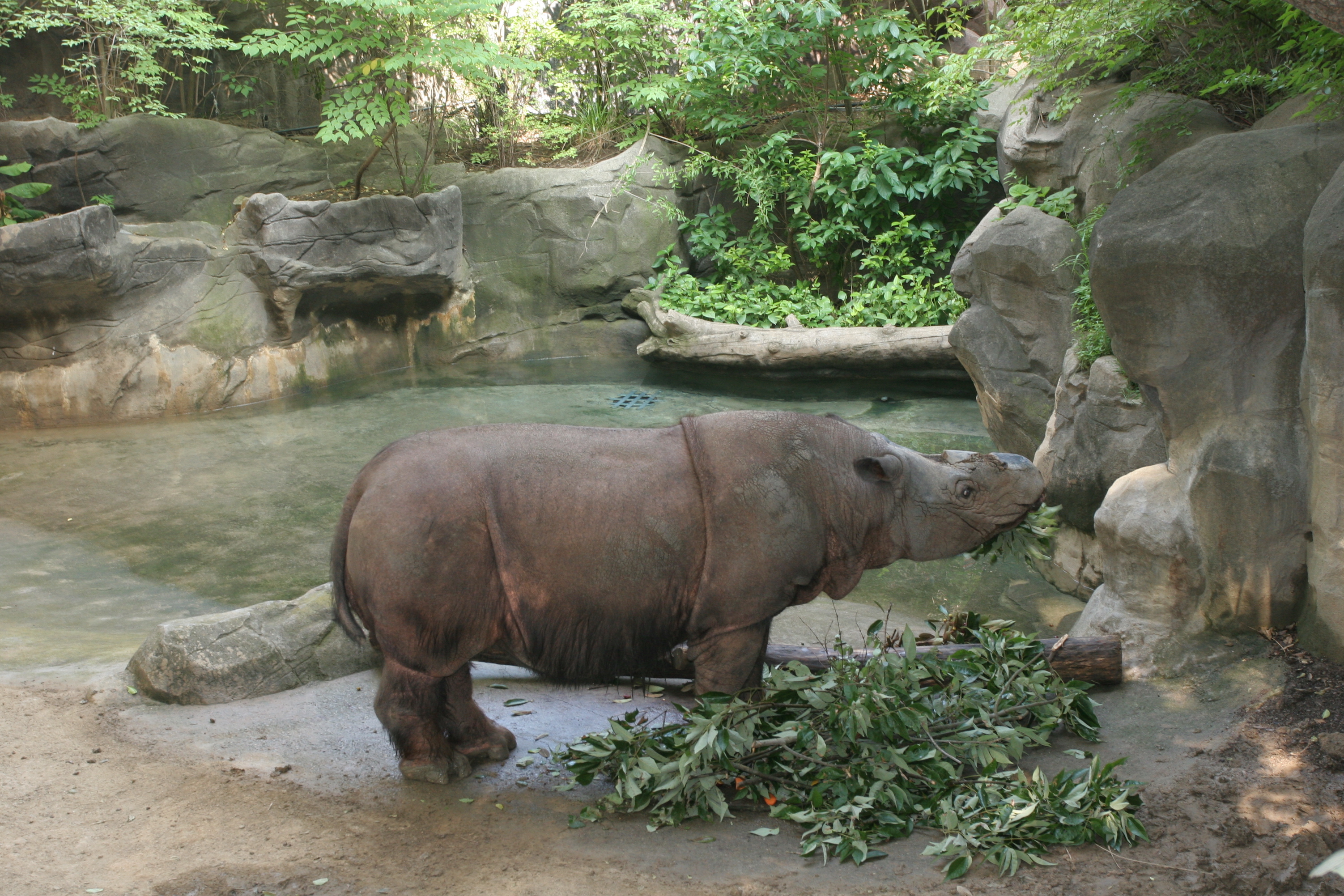
In 1991, Ipuh, a male, arrived at Cincinnati Zoo. He was already looking wan, so Cincinnati Zoo called San Diego Zoo to ask for some “browse,” i.e. trimmings of ficus trees growing around the zoo.
Reinhart says that when the keeper hosed off the branches, Ipuh responded immediately: standing up and coming over to smell the fresh branches.
“It took him about a year and a half to really come back to where he needed to be,” Reinhart says.
Another issue was disease. The rhinos, probably older and genetically inbred, were dealing with cancer, eye problems, iron storage disease, parasites, and in some cases bacterial infections. In a 2013 paper, Abdul Hamid Ahmad, John Payne and Zainal Zahari Zainuddin argued that some of the mortalities to disease could have been avoided.
“Most egregious of all, basic hygiene was generally poor [in Malaysian facilities], with at least some Sumatran rhinos kept for long periods in facilities that lacked basic hygiene protocols and biosecurity measures, and lacked experienced veterinary care,” they wrote.
As an example, the paper noted that treated piped water was only brought into Malacca Zoo for the Sumatran rhinos after two animals had died.
“I think a lot of … rhinos died through bacterial infections that could have and should have been treated with antibiotics but never were,” Payne says.
There were also accidents. A female named Melintang accidently strangled herself in an improperly constructed fence after being gifted to Thailand. A male named Tanjung was killed by a fallen branch — something that could have happened in the forest as well. Another male, Bulud, escaped his captors after only four months; he was never caught again.
Sungai Dusun
The worst 18 days for Sumatran rhino conservation came in October and November 2003. Five rhinos, four females and one male, died at the Malaysian Sumatran Rhino Centre in Sungai Dusun.
A male rhino, Shah, had died there a year earlier, followed by a female, Rima, just that April. Then, on Oct. 28, Seputin, a female, was found dead. Eleven days later, Ara, the only male, died. The next day, a female named Panjang died. The last two females, Minah and Mas Merah, died the following week.
With them went the entire captive population in Peninsular Malaysia.
“It was most painful to watch the great sufferings leading to the deaths of these precious animals,” Khan says.
No one knows for certain what happened. But two competing theories have taken root. One: that the animals died of trypanosomiasis, a type of parasite spread by biting flies.
“I would say that we have a lot of evidence indicating they died of trypanosomiasis,” says Terri Roth, a rhino expert and head of CREW, a research facility at Cincinnati Zoo, who was co-author of a paper that laid out the evidence a year after the tragedy. Roth and others believe that nearby water buffalo, which often waded in a canal that ran adjacent to the center, may have been the source. Flies may have bitten the water buffalo and then bitten the rhinos as well.
The other theory is that the animals died of bacterial infections, such as E. coli and pneumonia. According to the paper by Ahmad, Payne and Zainuddin, trypanosomes probably only infected the animals after their immune systems had already been weakened by E. coli and pneumonia due to allegedly poor management at the facility. Otherwise, they argued, why didn’t trypanosomiasis kill these animals during the 18 years prior?
“The conclusion that trypanosomes were the cause of the [Sungai Dusun] deaths may have been reached erroneously, in order to allow parties involved to avoid responsibility for chronic poor hygiene in the facilities,” the paper concluded.
Officially, the cause of death has been listed as trypanosomiasis.

“I visited the Sumatran Rhino Conservation Centre at Sungai Dusun several times,” Roth says. “In general, the facility was nice, the rhinos appeared healthy, well cared for and in good body condition.”
She says the staff had succeeded in mating the males with the females, but without a successful birth due to fertility problems.
“I believe Sungai Dusun has received much undeserved criticism due to its tragic ending,” she adds. “Sure, it was not perfect, but it was a decent facility where rhinos frequently mated.”
After the center lost all of its rhinos, Sungai Dusun switched to housing Asian tapirs. In 2010, seven tapirs died of E. coli and pneumonia.
Whatever, the cause of the tragedy at Sungai Dusun, it highlighted a salient point: housing too many endangered animals in one area is incredibly risky.
“That’s why we worry so much about something like that happening at the Sumatran Rhino Sanctuary [in Way Kambas] because those rhinos are close enough [in] proximity that if one gets sick with something like that, it could spread very quickly,” Roth says.
The fallout for Malaysia was swift and large.
“Tom [Foose] thought that we were sabotaged and withdrew the [U.S.] funds,” Khan says. “I crawled to find money and by 2010-2011 our rhinos were thought extinct.”
Where Did it All Go Wrong?
By 1995, the captive-breeding rhino program looked doomed. Forty animals had been caught — 12 from Peninsular Malaysia, 10 from Sabah and 18 from Sumatra. And a shocking 19, nearly half, were dead. And this was before the disaster at Sungai Dusun.
Exacerbating this failure, the program hadn’t produced even a single calf 11 years after the landmark meeting in Singapore — even though the entire goal of the program ostensibly was to create baby rhinos. In 1993, the Sumatran Rhino Trust, once such a promising endeavor, went belly-up.
Not only did the program look doomed, it looked like a conservation embarrassment.
Payne says he believes the original sin of the captive-breeding program was its commitment to only taking animals out of populations that were already destined to vanish because of either too few rhinos or impending logging and agriculture. This, he says, was at once politically expedient and a good cover against critics who argued rhinos shouldn’t be removed from the wild. But it also meant conservationists were removing rhinos that were more likely to be old, genetically inbred, and hadn’t seen another living rhino in ages.
“It was a fateful flaw right from the beginning to only catch doomed rhinos because it was all the trash, old, [reproductively] unfit ones that were then going to be captured,” Payne says.

Many of the females caught already had or quickly developed reproductive issues, including uterine tumors, likely due to going without breeding for so long. Rhinos, even in large protected areas, had simply become too few to find each other, according to Payne.
“People assume the rhinos know where each other are, and they’re humping each other. Of course they don’t … They just live out their life there … without ever breeding,” he says.
Over time such tumors made the females totally infertile. The males, meanwhile, may have arrived already aged, with low sperm counts.
“You can’t have a successful breeding program if you don’t have reproductively viable animals,” says the International Rhino Foundation’s Ellis, noting that when the SRS in Way Kambas started in 1996 it didn’t have any breeding success until 2005, when it got a young female, Ratu, from the wild.

The trapping program in Sumatra was the only one that didn’t result in a gender imbalance: seven males to 10 females (not including one that died in the trap).
This gender imbalance was worsened by an unwillingness both to share the rhinos internationally or to combine subspecies. Had Sabah and Peninsular Malaysia been willing to mix their two different subspecies, they may have had more luck breeding, since Sabah had mostly males and Peninsular Malaysia mostly females.
Although the groups pledged cooperation and to do the best they could for the species, this didn’t always happen. For example, Malaysia, which had refused to send any rhinos to the U.K. or the U.S., sent one of its female rhinos as a gift to the king of Thailand in 1985. She died after one year, mateless, when she got caught in her fence at Bangkok’s Dusit Zoo and accidently strangled herself. Sometimes, a single rhino would linger for years at a facility without a mate.

The decision by both Sabah and Peninsular Malaysia meant that zoos in the U.S. and U.K. had, at best, only a couple of rhinos to attempt any captive breeding.
“We didn’t have enough animals to work with. We had a small handful of them, but we had to learn all of this from these few animals,” says Maruska from Cincinnati Zoo, the first institution to actually achieve a birth. “If we could have had our full limit of the 25 animals, the program would have been … more apt to be successful.”
At the same time, feeding the animals the wrong food and trying to overcome disease meant many animals didn’t survive long. Erong, a male calf caught in Peninsular Malaysia in 1984, was an extreme example.
“Full cream milk was given by a ranger and he was told to stop it,” Khan says. “Erong was so young and could not digest the milk. I believe it was the cause of death … We looked and shudder[ed] in great fear as it died in front of us.”

Much of this, of course, isn’t exactly shocking, given so little was known about this species in the wild. But the situation was exacerbated by what Payne calls “unhealthy competition” among institutions and an unwillingness to share information — a problem that some sources say continues to plague conservation efforts today.
Maruska also says they waited too long.
“It’s the same thing they did with the California condor, they wait till there’s a small number of animals and then it’s the last, last ditch attempt to [breed the species]. Instead of looking ahead.”
In 1995, at the height of the program’s problems, a new paper hit like a bomb. Alan Rabinowitz’s now classic “Helping a Species Go Extinct: the Sumatran Rhino in Borneo” eviscerated the decade-long strategy. A hugely respected conservationist, Rabinowitz, then with the Wildlife Conservation Society, harshly criticized the approach to Sumatran rhinos, which he wrote focused “time, money and effort” on captive-breeding efforts over protection in the wild.
“In Sabah, the easiest, most palatable, and most visible steps … were taken first,” he wrote. Habitat was only protected when it was “not controversial” and “caused minimal interference with ongoing logging activities and agricultural development plans.”
In the paper, Rabinowitz disputed the idea that many of the rhino populations were already doomed, calling such research “removed from the real world.” Instead, Rabinowitz said successfully protecting the species required tackling the threats of habitat destruction and poaching via more protected areas and more boots on the ground.
“The implication that captive breeding can save the Sumatran rhino makes the failure of in situ conservation less serious. This, in turn, helps create a self-fulfilling prophecy that wild [populations] have a low probability of survival,” he wrote.
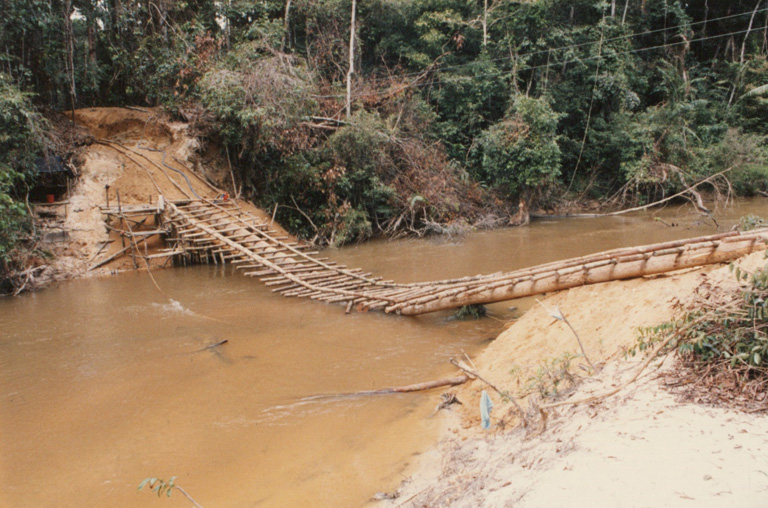
In the paper, Rabinowitz pointed out that by 1995 we still didn’t know how many rhinos were actually left — a fact still true more than 20 years later.
“While some of the blame … must be placed on the Indonesian and Malaysian governments, the rest of it falls squarely in the lap of international funding and conservation organizations,” Rabinowitz wrote, saying that NGOs had refrained from calling for anything difficult in order to avoid “becoming an unwelcome guest.”
Basically, conservation NGOs had bent over backward to agricultural and logging interests, a fact that still often proves true today.
In May this year, shortly before his death in August, Rabinowitz told Mongabay that his opinion of that early program hadn’t changed. However, he said what had changed was the situation today, both in terms of captive-breeding success and rhino populations on the ground.
In 1995, the last rhino for the captive-breeding program was caught in Sabah. His name was Malbumi. He would be dead in less than 18 months. The cause? Uncertain.
